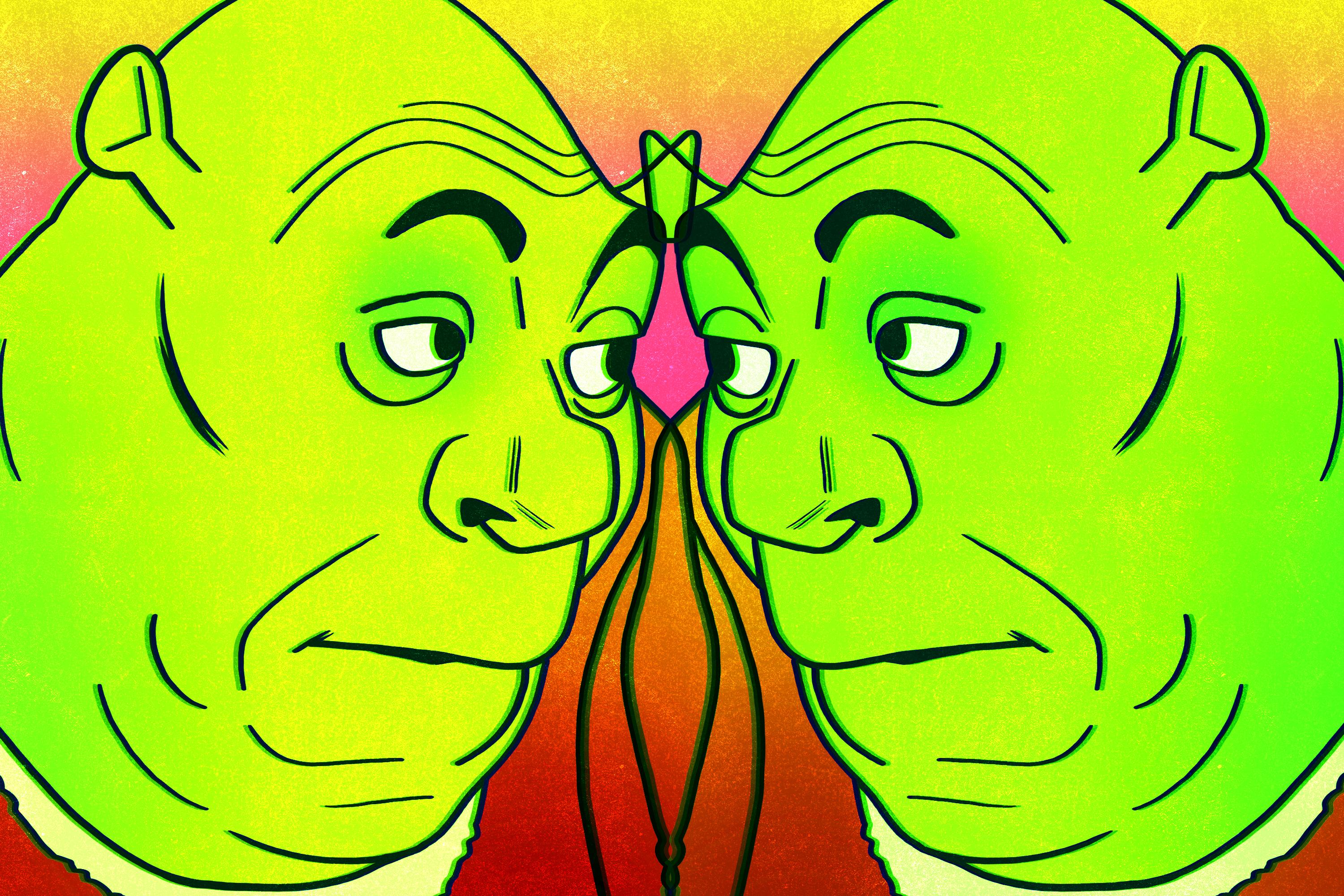
May 18 marks an important milestone in the history of cinema: the 20th anniversary of Shrek. From a billion-dollar film franchise and Broadway musical to a theme-park ride and a plethora of modern-day memes, there’s no denying the cultural impact of the green ogre. Shrek changed the animation game forever (and if you’re doubting its prestige, tell us why it premiered at Cannes!). To mark the occasion, The Ringer is celebrating Shrek Day, an exploration of the animated fairy tale’s legacy.
The internet does not, as a rule, agree on much. That which is most sacred in some corners online—waffle fries, your favorite pop star, skinny jeans, bodegas—brooks outrage and disgust elsewhere. Every opinion is a ratio waiting to happen, every duck just a milkshake away from infamy. Except, that is, for Shrek, the strongest consensus fave this side of Waluigi.
Shrek, the starring green ogre of Shrek, is everywhere. Twenty years after the hit film’s release, he is still a meme of baffling proportions, from Shrek ASMR to the phrase “Shrekt,” to the consummate ouroboros. As we Jet Ski through social media’s TikTok era, the latest iteration of the meme is for creators to do Shrek next—that is, to take whatever their particular thing is, and filter it into something green and spindly-eared. Which is how you get swole cake Shrek and, uh, Hot Shrek:
“Shrek is perfect meme fodder because it’s an omnipresent cultural artifact that also happens to be sort of goofy,” says Rebecca Jennings, who covers internet culture for Vox. “I’m reminded of SpongeBob and Bee Movie, two things that have also been memed to infinity and both feature animated characters that are just this side of uncanny.”
I would suggest that I am the first to propose Shrek represents a grand experiment of the tabula rasa, but I am almost certainly not. Like a sea sponge or a cartoon pollinator, Shrek has become all things to all people.
What does Shrek stand for? The better question might be: What doesn’t he? He is an ally of women, of comrades everywhere, of Arsenal’s mascot. He is sadly not an ally of the University of Toledo, though things seemed to be trending that way for a bit.
Does Mark Hamill know why it was funny for him to look like Shrek? Could Regis Philbin ever have imagined that people would still be watching his in-costume Letterman appearance more than a decade after it happened? Does Nicolas Cage’s what-if casting add to the hilarity, and if so, could anyone ever explain to Cage why? A YouTuber filmed himself taking a bite out of a raw onion (ogres are a lot like onions, duh) every day for 700 days to protest the lack of new Shrek movies; a Twitter user spent more than a year tweeting out the entirety of the three Shrek movie scripts, line by line. The harder you try to make sense of it all, the less sense it will make.
So why, of all the weird pop culture phenomena, has Shrek endured? It likely owes more than a little to timing: With the movie releases stretching from 2001 to 2011 (including the spinoff Puss in Boots), the series caught a generation of viewers as they were both the right age to watch in the first place and as they were taking to nascent social media platforms—with their blooming ability to have things go viral—and beginning to learn the noble arts of shitposting. The first two movies, released in 2001 and 2004, were genuine sensations: Shrek 2 grossed nearly a billion dollars worldwide and, until Finding Dory finally took its crown in 2016, was the highest-grossing animated film ever in the United States.
“There are really two waves of Shrek memes happening here,” says Ryan Broderick, whose newsletter Garbage Day chronicles memes and digital culture. The first wave, he says, is “the dank meme stuff.” “This, I think, is largely a reaction to the overcommercialization of the franchise when it first came out. Shrek was branded on everything. This ties together to the DreamWorks smirk and other sort of late-stage capitalist parodies that become memes. Mountain Dew comes to mind here. So you have this big, ugly, absurdist Shrek thing happening and it kind of peaked around 2014 to 2015, during the 4chan-Reddit-Tumblr cultural arms race. Right before those corners of the internet soured and radicalized.”
Something changed after that, Broderick says. “Then you have a second, newer wave, where younger users, and I suppose older ones too, finally have enough distance on Shrek to realize that it’s actually a great movie.” He compares this stage to the backlash-to-the-backlash that’s surrounded Food Network star Guy Fieri, who—having spent much of the aughts as the butt of just about everyone’s joke—is now a cult favorite with many defenders among those who used to have fun at his expense.
“A lot of the very capitalistic and gaudy pieces of mid-aughts culture, that were always considered sort of overexposed and ugly, are now beginning to feel sort of sweet and nostalgic,” Broderick says. “Because the internet is confusing and nonlinear, both of these meme cycles around Shrek are kind of happening at once.”
There’s also the fact that Shrek itself seems built for close dissection by audiences older than the ones who probably went to see it in theaters. See: a recently discovered Easter egg that seems to show Lord Farquaad—Lord Farquaad, do we even need to go on?—summoning an image of his love Fiona while in bed, then getting what is clinically referred to as a massive boner. And that the movie’s grand finale is soundtracked by Smash Mouth, a band that became an early memetic obsession of Weird Twitter, and that continues to beat a drum for the series on social media. (Smash Mouth would also like you to know that “All Star” was a no. 1 hit even before Shrek, thank you very much.)
There is also the small matter of a certain extremely NSFW corner of Shrek fandom, which I regret to inform you, dear reader, is so rampant as to be part and parcel with the rest of the character’s memedom. (Shrek’s fictional entanglements with Shadow from the Sonic the Hedgehog franchise date back at least to 2010.) There are, for example, two types of people on the internet: those who have seen the picture of Shrek in which he is, well, nude (as well as a fluorescent shade of green), and those who have not. (I will not link to it, and if you decide you must see it for yourself, consider this your warning; please make sure there are no children in your home, now or maybe ever.) This has somehow turned into the most well-known Shrek meme, a sort of latter-day Goatse that cycles through particularly chaotic group chats and DMs. The Shrek fandom is undeniably and inescapably horny.
None of it really makes sense. But perhaps, as with the earlier, smaller, simpler internet that first manifested the meme version of Shrek, it doesn’t have to. While so much of social media—at least in my not-quite-geriatric corner of the web—has been filled in recent years by millennials clutching their pearls, alternatively mortified and furious that Gen Z either finds them uncool or, worse, simply doesn’t think about them at all, Shrek has been an equalizer; a strangely timeless, malleable oddity. That, at least, does make a kind of sense, given the cinematic provenance. As Smash Mouth put it last year, almost two decades after the band’s fairy-tale star turn, “every kid watches Shrek.”
“I think people love him because he’s ugly and sort of gross,” Jennings says. “What’s more relatable than that?”

